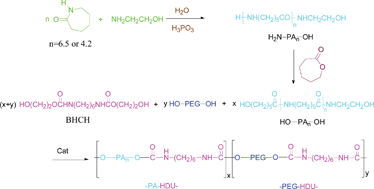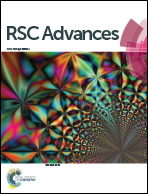Synthesis and characterization of aliphatic segmented poly(ether amide urethane)s through a non-isocyanate route
Abstract
Two nylon-6 oligomers with polymerization degrees (DP or n) of 6.82 and 4.52 terminated with H2N- and HO-groups (H2N–PAn–OHs) were prepared from caprolactam with ethanolamine via ring-opening polymerization at different molar ratios, and transformed into HO-terminated nylon-6 oligomers (HO–PAn–OHs) through reaction with excess caprolactone. Melt polycondensation of the HO–PAn–OHs, with 1,6-bis(hydroxyethyloxy carbonyl amino)hexane (BHCH) and polyethylene glycols (PEGs), was performed at 170 °C under normal pressure and at 180 °C under reduced pressure of 3 mmHg at different periods. A series of novel aliphatic thermoplastic poly(ether amide urethane)s with different short nylon-6 and PEG segments (s-PEAUs) was prepared. The obtained s-PEAUs were characterized by gel permeation chromatography, FTIR, 1H-NMR, 2D 1H–1H COSY NMR, differential scanning calorimetry, thermogravimetric analysis, wide-angle X-ray scattering, and tensile tests. The s-PEAUs exhibited an Mn up to 18 400, an Mw up to 48 900, Tm between 145.94 °C and 177.86 °C, initial decomposition temperature of over 253.39 °C, and tensile strength up to 30.03 MPa with elongation at break of 286.8%. Some urea linkages were formed during transurethane polycondensation.


 Please wait while we load your content...
Please wait while we load your content...